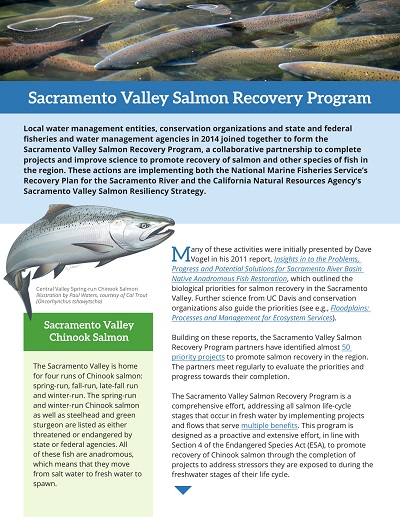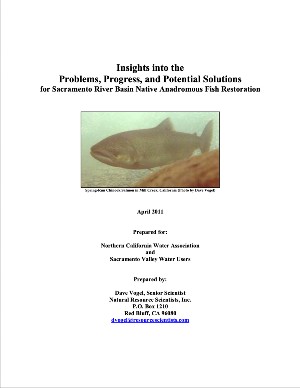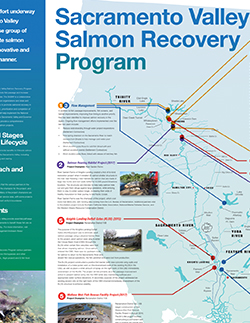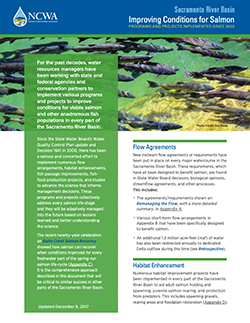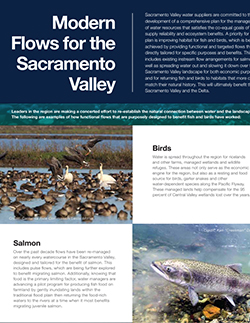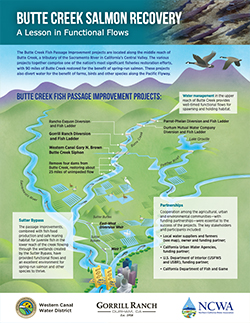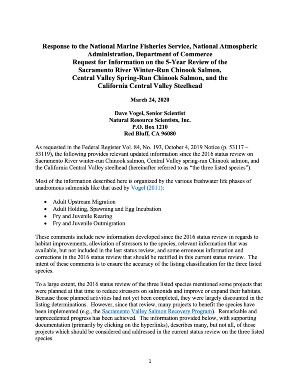Sacramento Valley Salmon Recovery Program
Based upon the recommendations contained in Dave Vogel’s 2011 report Insights into the Problems, Progress and Potential Solutions for Sacramento River Basin Native Anadromous Fish Restoration, NCWA formed the Sacramento Valley Salmon Recovery Program in 2015 to implement priority projects to promote salmon recovery. This effort led to the development of a comprehensive list of functional flows and habitat projects that have been reviewed by state and federal fishery and water management agencies, conservation organizations and local water management entities. For the first time, this effort has identified priority projects for all salmon life cycle stages that occur upstream from the Delta. The program will implement the National Marine fisheries Service’s Recovery Plan for the Sacramento River, California Natural Resources Agency’s Sacramento Valley Salmon Resiliency Strategy.
- Sacramento Valley Salmon Recovery Program Summary
- Insights into the Problems, Progress and Potential Solutions for Sacramento River Basin Native Anadromous Fish Restoration
NOAA Fisheries Recovery Plan
In July 2014, NOAA Fisheries released a Recovery Plan for Sacramento River winter-run
Chinook salmon, Central Valley spring-run Chinook salmon, and Central Valley steelhead. This recovery plan shares many priorities with the Sacramento Valley Salmon Recovery Program (SVSRP) and the SVSRP will help to implement the plan.
- NOAA Fisheries Recovery Plan
- Recovery Plan Press Release
- Species in the Spotlight – Sacramento River Winter-run Chinook Salmon
California Salmon Strategy for a Hotter, Drier Future
The California Salmon Strategy was released in January 2024 with the goal of restoring the state’s populations of salmon “amidst hotter and dryer weather exacerbated by climate change.” The strategy includes six priorities – removing barriers and modernizing infrastructure for salmon migration, restoring habitat, protecting water flows in key rivers at the right times, modernizing hatcheries, transforming technology and management systems, and strengthening partnerships.
Central Valley Salmon Habitat Partnership
In 2017, parties to the Central Valley Salmon Habitat Partnership, including NCWA adopted a charter to form the Central Valley Salmon Habitat Partnership.
The Partnership brings existing salmon and steelhead recovery efforts together, prioritizing projects to support the rapid rebound of these native fish populations.
The CVSHP will develop an Implementation Plan that relies on the best available science to identify priority restoration projects to support a variety of habitat types for salmon and steelhead. The Plan will ensure that funding is used efficiently by coordinating efforts among government agencies, conservation groups, water suppliers, and private landowners to ensure projects are prioritized to maximize benefits to salmon and steelhead in the Central Valley.
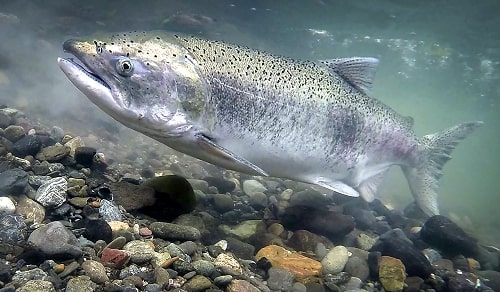
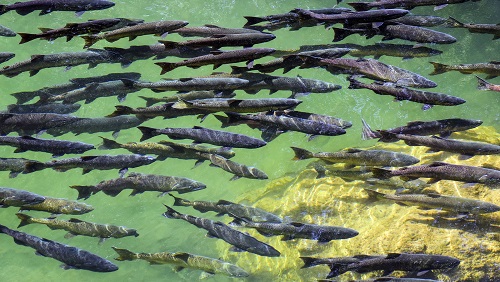

Producing Food for Juvenile Salmon
Prior to the development of the flood control system in the Sacramento Valley, rivers in the region would rise above their banks during high flows during the winter and spring months and spread out across the landscape, slowing in velocity creating ideal shallow water habitat and food production for juvenile salmon. Today, levees and other flood control projects have separated the rivers from the floodplains, preventing the interaction of water with the landscape that is necessary to grow food for juvenile fish. Several efforts are underway to spread water out and slow it down in the region’s bypasses and on harvested rice fields to recreate the habitat and food that once occurred naturally in the region. Below are descriptions of these various efforts.
